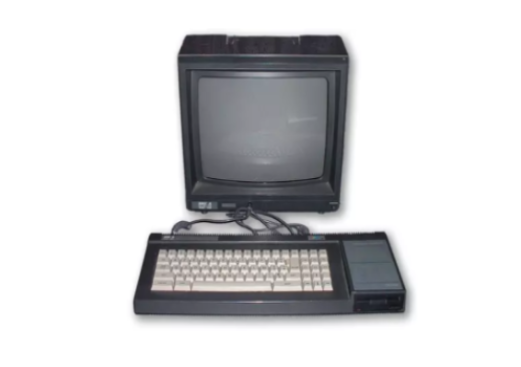Atari ST oli 1980-luvulla suosittu kotitietokone, joka yhdisti tehokkaan suorituskyvyn, suhteellisen edullisen hinnan ja käyttäjäystävällisen graafisen käyttöliittymän. Atari ST (ST viittaa sanoihin Sixteen/Thirty-two, viitaten sen 16/32-bittiseen arkkitehtuuriin) julkaistiin vuonna 1985, ja se asettui markkinoilla kilpailemaan erityisesti Commodore Amigan, Apple Macintoshin ja IBM PC:n kanssa. Tietokone löysi käyttäjiä niin kotitalouksista, pienyrityksistä, musiikkistudioista kuin pelikehittäjienkin työpöydiltä.
Atari ST:n kehityksen taustalla oli kotitietokonemarkkinoiden nopea kasvu ja teknologian edistyminen. Atarin toimitusjohtajana toiminut Jack Tramiel, joka oli aiemmin johtanut Commodorea, hankki Atari Inc:n kuluttajatuoteliiketoiminnan vuonna 1984. Tramielin tavoitteena oli luoda tehokas, mutta kohtuuhintainen tietokone, joka vastaisi sekä yritys- että kotikäyttäjien tarpeisiin. Atari ST:n kehitystyö alkoi pian Tramielin johdon alaisuudessa. Tietokone suunniteltiin nopeasti, ja se esiteltiin yleisölle jo tammikuussa 1985 CES-messuilla Las Vegasissa. Ensimmäiset laitteet toimitettiin kesällä 1985, jolloin 260ST tuli myyntiin. Atari ST:n kehityksen johtajana toimi Shiraz Shivji, joka oli työskennellyt aiemmin Commodorella Jack Tramielin alaisuudessa. Shivji johti suunnittelutiimiä, joka kehitti ST:n vain muutamassa kuukaudessa. Tiimin nopea työskentelytapa mahdollisti tietokoneen julkaisemisen kilpailijoidensa edellä, mutta jätti myös joitakin kompromisseja laitteiston ja ohjelmiston laadussa.
Atari ST oli menestys monilla markkinoilla, erityisesti Euroopassa. Sen myyntiluvut ovat arvioiden mukaan 4-5 miljoonaa kappaletta maailmanlaajuisesti. Ensimmäisenä vuotenaan Atari ST myi erittäin hyvin, ja se löysi vakiintuneen käyttäjäkunnan erityisesti harrastajien ja musiikkistudioiden keskuudessa.
Atari ST:n suunnittelussa hyödynnettiin markkinoiden uusinta teknologiaa, ja se tarjosi tuon ajan mittapuulla erinomaisen suorituskyvyn ja monipuolisuuden.
- Prosessori: Motorola 68000, 16/32-bittinen suoritin, joka toimi 8 MHz:n taajuudella.
- Muisti: Alkuperäiset mallit toimitettiin 512 kilotavun (520ST) tai 1 megatavun (1040ST) RAM-muistilla.
- Näyttö:
- 320×200 pikseliä, 16 väriä (ST-Low)
- 640×200 pikseliä, 4 väriä (ST-Medium)
- 640×400 pikseliä, mustavalkoinen (ST-High)
- Tallennusmedia:
- 3,5 tuuman levykeasema (ensimmäisissä malleissa ulkoinen, myöhemmin sisäänrakennettu).
- Mahdollisuus liittää ulkoinen kovalevy.
- Ääni: Yamaha YM2149F -äänipiiri, joka tarjosi 3-kanavaisen äänen.
- Käyttöjärjestelmä: TOS (The Operating System) ja GEM (Graphical Environment Manager), jotka tekivät Atari ST:stä yhden ensimmäisistä tietokoneista, jossa oli hiirellä käytettävä graafinen käyttöliittymä.
- Liitännät:
- MIDI-portit (ainutlaatuinen ominaisuus, joka teki ST:stä erityisesti muusikoiden suosikin).
- Sarja- ja rinnakkaisportit.
- Joystick-liitännät ja laajennusportit.

Atari 520 STE -tietokone ja Wolfenstein 3D peli. Kuva otettu Assembly summer 2022-tapahtumassa Helsingin messukeskulksessa.
Ohjelmistot ja pelit
Atari ST tunnettiin laajasta ohjelmisto- ja pelivalikoimastaan. Tärkeimpiä ohjelmistokategorioita olivat musiikkisovellukset, pelit ja hyötyohjelmat.
Suosittuja pelejä
- Dungeon Master: Roolipeli, joka esitteli uudenlaista grafiikkaa ja pelimekaniikkaa.
- Elite: Legendaarinen avaruussimulaattori.
- Lemmings: Viihdyttävä ja innovatiivinen pulmapeli.
- Turrican: Toimintapeli, joka hyödynsi ST:n graafisia kykyjä.
- Falcon: Lentokonesimulaattori, joka oli suosittu harrastelijapilottien keskuudessa.
Musiikkiohjelmat
Atari ST:n MIDI-portit tekivät siitä suositun erityisesti musiikintuotannossa. Tunnettuja musiikkisovelluksia olivat:
- Cubase: Ammattitason musiikkituotantotyökalu.
- Notator: Nuotinnusohjelma ja sekvensseri.
Atari ST oli ainutlaatuinen yhdistelmä edullisuutta, suorituskykyä ja monipuolisuutta. Vaikka se ei voittanut kilpailua Commodore Amigan tai IBM PC:n kanssa, se jätti pysyvän jäljen erityisesti musiikintuotantoon ja harrastelijapiireihin. ST:n historia on tärkeä osa tietokoneiden kehityksen tarinaa.
Muusikot ja Atari ST
Atari ST:n MIDI-portit tekivät siitä erityisen houkuttelevan muusikoille, koska sen avulla pystyi helposti ohjaamaan syntetisaattoreita ja muita MIDI-yhteensopivia laitteita. Seuraavat tunnetut muusikot ja yhtyeet käyttivät Atari ST:tä musiikkituotannossa:
Tunnetut muusikot ja Atari ST
- Jean-Michel Jarre
- Elektronisen musiikin pioneeri käytti Atari ST:tä MIDI-sekvensserinä studioissaan.
- Cubase ja Notator olivat Jarrelle tärkeitä työkaluja.
- Depeche Mode
- Yhtyeen jäsenet käyttivät Atari ST:tä kappaleidensa säveltämiseen ja äänityssessioiden hallintaan.
- MIDI-yhteensopivuus oli keskeisessä roolissa heidän monimutkaisessa elektronisessa tuotannossaan.
- Mike Oldfield
- Tunnettu erityisesti kappaleestaan Tubular Bells. Atari ST oli osa hänen studiotyöskentelyään.
- Notator ja Cubase olivat hänen käyttämänsä ohjelmistot.
- Fatboy Slim (Norman Cook)
- Käytti Atari ST:tä varhaisessa vaiheessa musiikkituotannossaan ennen siirtymistään digitaalisiin audioasemaratkaisuihin.
- Pet Shop Boys
- Atari ST oli keskeinen osa heidän musiikkinsa tuotantoa, erityisesti MIDI-laitteiden hallinnassa.
- Erasure
- Elektronisen musiikin duo hyödynsi Atari ST:tä kappaleidensa säveltämisessä ja live-esiintymisissä.











 Commodore 128 -tietokone toiminnassa I love 8-bit -näyttelyssä. Mukana on GEOS graafinen käyttöliittymä, joka on aikansa windows Commodore-tietokoneilla.
Commodore 128 -tietokone toiminnassa I love 8-bit -näyttelyssä. Mukana on GEOS graafinen käyttöliittymä, joka on aikansa windows Commodore-tietokoneilla.




